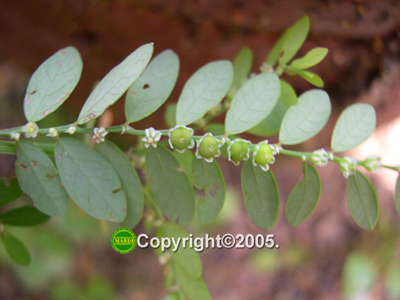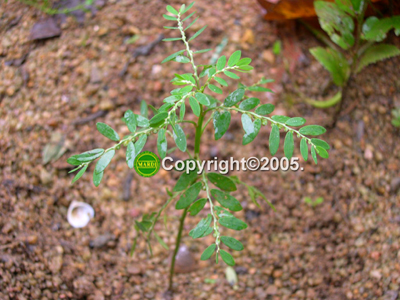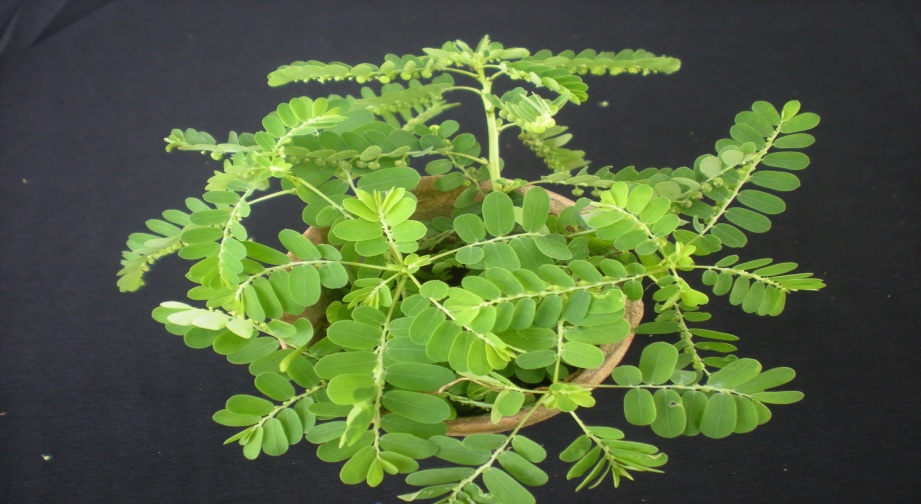Dukung Anak or scientifically known as Phyllanthus, is a medicinal herbal plant that have tremendous number of species varieties. P. amarus, P. niruri, P. urinaria and P. debilis are among the common varieties that can be found at tropical climate regions such as Malaysia, Indonesia, Thailand, China and North America.
Dukung Anak is also known as buah amin, rami buah, turi hutan, nipon-nipon (Malaysia), chanca piedra (India), keelaanelli (Tamil), meniran (Indonesia), quebra pedra (South America), zhen chu cao, ye xia zhu (China), stone breaker, shatter stone, and child pick-a-back (English).
Dukung Anak is usually spotted on hard surfaced soil, for instance between the gap of cement crack. It is mostly found in deserted areas, sidewalks, vegetable gardens or inside flower pots. It grows wildly on the edge of plant lines and is considered as a hardly controlled weed plant. Despite that, this plant has various medicinal properties and is widely recognized among traditional healthcare practitioners.
Description
Dukung Anak plant is a small annually grown herb, which grows in the range of 50-70 cm in height and can be easily identified by its small pod which elongates along the side of its leaves. Dukung Anak leaves are oval-like shape, green or red in colour with the size of 2-3 mm length while the fruits are formed underside of leaf rachis.

Dukung Anak leaves and fruits

Dukung Anak plant

Dukung Anak plant
(Source: http://agromedia.mardi.gov.my/MEPIS/index.php/galeri-herba-2/55-dukung-anak)
Traditional Use
The roots, leaves, fruits and the whole parts of Dukung Anak plant have many medicinal values. The powder form (extracted from dried plant) or freshly prepared plant are very popular in India for Ayuverdic medicines.
It is also widely used in China and South America as herbal medicine to treat liver related disease, cholelithiasis, malaria, and asthma. Additionally, this plant can function as diuretic and appetite stimulant.
In Malaysia, Dukung Anak is commonly used to help in treating kidney related disease and liver disease such as jaundice and Hepatitis B. The fresh part of roots may reduce jaundice disease especially in a new born baby. The fruits can also aid the wound healing process, lethargy and skin disease like ringworm infection. The salted leaves in pulverized form may be used to treat scabies. Additionally, the root or leave extract can be used to strengthen spleen. The decoction of Dukung Anak leaves is useful in treating cough.
The plant is also commonly used to treat kidney stones, diabetes, hypertension, insect bite, pruritus and diarrhoea. It is used as diuretic and tonic for miscarriage as well as for the treatment of gonorrhea and syphillis.
A study has found that the extract of Dukung Anak (P. niruri) is effective in protecting internal organs especially liver and kidney. The extract from P. niruri can inhibit the formation of calcium oxalate and therefore, it can promote the treatment of cholelithiasis of the liver or bile. Besides, there is a research that shows Dukung Anak has a positive impact in combating Hepatitis B virus.
Dukung Anak consists of many chemical functional groups such as phenolics, lignans and xylans which may be useful in treating or controlling the above mentioned diseases.
Traditional Products Containing Dukung Anak
The demand on Traditional products as alternative medicines have now increasing significantly in Malaysia. Hence, it is very important for manufacturers or product distributors to ensure those products are of quality and safe for public consumption. A monograph herbal of Dukung Anak, can be found at Globinmed website (www.globinmed.com), is one of Ministry of Health Malaysia (MOH) initiatives to assist manufacturers or traditional product distributors in achieving the goal. Herbal Monograph is a guideline for manufacturers to conduct quality control tests such as Identification Test (confirmation test of Dukung Anak as raw material used in the product) and other safety tests like Microbial Contamination Test.
Consumers should wisely select or purchase traditional products in the local market. They are advised to buy registered traditional products which have labelled with MOH registration number and hologram logo on the packaging label.
The consumers are also advised to seek medical attention if allergies or adverse reaction occur when taking these traditional products.
References
- Paithankar V.V., Raut K.S., Charde R.M., Vyas J.V: Phyllanthus Niruri: A Magic Herb, Research in Pharmacy 1(4):1-9 (2011)
- Jamal J.A: Malay Traditional Medicine. An Overview of Scientific and Technological Progress, Tech Monitor (Nov-Dec 2006)
- Gyana R. R: Phylogenic Study of Twelve Species of Phyllanthus Originated from India through Molecular Markers for Conservation, American Journal of Plant Sciences, 2010, 1, 32-37
- Dhandayuthapani K., Sundaramoorthi K. R. et.al : Systematic Studies in Herbaceous Phyllanthus Spp.(Region: Tiruchirappalli District in India) and A Simple Key To Authenticate ‘Bhumyamalaki’ Complex Members , Journal of Phytology 2011, 3(2): 37-48
- http://www.bio-asli.com/herb/dukunganak.asp
| Last Reviewed | : | 30 June 2016 |
| Writer/Translator | : | Nik Juzaimah bt. Juhari |
| Accreditor | : | Dr. Noraida bt. Mohamad Zainoor |







